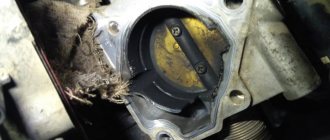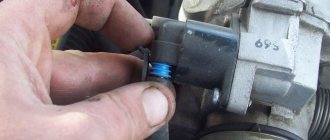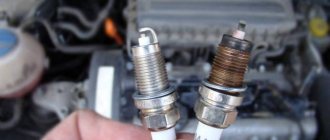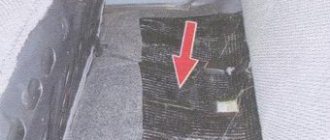The car engine is switched to idle mode (idle speed) by command from the electronic control unit (ECU). This happens at the time of start-up or when it is necessary to warm up the engine. The engine is in this state when the transmission is turned off, when the car is stopped, for example, at a traffic light. The engine operation is controlled by a special idle speed sensor (IAC). Usually it does not cause any special problems, but its breakdown can cause a lot of trouble for drivers. That is why the performance of the DCS must be constantly monitored and, if defects appear, they must be promptly eliminated.
Design
Any DXH provides air flow inside the engine when the throttle valve is closed. Moreover, if previously the idle speed sensor of the carburetor VAZ 2109 functioned as a shut-off valve, the calibrated hole of which could only be either open or closed, then the new idle speed sensor VAZ 2109 injector is capable of independently, depending on the position of the throttle valve, reducing or increasing the amount air, which is needed at different periods of time. That is why experts consider the new version of the IAC not to be a sensor, but a measuring device, and recently it has received the name idle air controller (hereinafter referred to as IAC).
The idle speed control of the VAZ 2109 injector is structurally reminiscent of a miniature module; in addition to the stepper motor, its body contains a rod with a needle with a cone-shaped tip.
The IAC is secured to the throttle body housing with two screws.
The device is also equipped with a 4-pin connector designed to connect the device to the car's ECU.
Knock sensor
Any motorist knows that good proper operation of the engine depends on optimally selected ignition timing angles; ideally, they are different for each engine operating mode. This is why there is an ECU, whose main task is to set these angles as ideally as possible using a knock sensor. It is he who can accurately determine that the ignition timing is set incorrectly. The ECU program is written to set the ignition timing as large as possible in order to prevent the engine from going into the detonation zone.
If the knock sensor of a VAZ 21099, 210115 or other car brands fails, then the engine begins to overuse fuel, overheat and stall, it loses traction and the timing belt wears out greatly. The VAZ 21099 knock sensor is considered broken, the injector of which begins to produce the following tricks:
You can buy a VAZ 21099 knock sensor at any auto store for up to 200 rubles, or install a Volgov one, which costs up to 500 rubles and has unsurpassed quality.
Principle of operation
The basic principle of operation of the IAC is reduced to changing the cross-sectional area of the calibrated hole in the bypass channel based on the current position of the throttle valve. This change begins with the translational movement of a needle connected to the armature of a stepper motor through a worm gear. Completely closing the bypass channel with the throttle valve fully open does not affect the operation of the power unit. When the needle moves back, the amount of air increases in proportion to the closing angle of the throttle valve. Due to this, it is possible to smoothly regulate the crankshaft speed during the transition from the operating state of the car engine to the idle mode.
Where to begin
You should start setting up the Solex 21083 carburetor by adjusting the fuel level in the float chamber. This involves directly starting the engine and warming it up for five minutes. Then the motor is turned off and the following steps are performed:
The fuel supply hose is carefully separated to prevent gasoline from entering the chamber during further operation. The five screws securing the cover are removed. The choke system cable is removed. The lid is lifted horizontally with extreme caution so that the floats are not damaged. In the chamber itself, the fuel level is measured using a ruler or caliper.
The distance from the top level of gasoline to the edge of the sealing surface of the lid should be from twenty-three to twenty-five millimeters. It is necessary to select an average value, since the fuel level is not able to be in a constant state due to the manifold, which itself does not have the ability to be in a horizontal position all the time. If there is a deviation from the norm in the parameters set earlier, then it is enough to bend the float holders to correct the situation.
Some gasoline is then removed and the reverse carburetor assembly process begins. The key word here is reverse, which means performing the same process, but starting from the end.
If the parameters are within the permitted standards, then the adjustment of the Solex carburetor ends here. Then the transition to the next stage occurs.
IAC connection diagram and its operation
The IAC is connected to the ECU control controller with a 4-wire harness through a standard connector.
The existing electrical circuit does not allow the driver to influence the operation of the IAC, since the control algorithm of the controller is reflashed exclusively on special equipment.
The IAC mechanism works according to the algorithm indicated below:
- When you turn the ignition key, the regulator rod moves to its extreme position and the calibration hole of the air pumping channel in the throttle pipe is completely closed.
- The IAC returns the valve to the primary position after starting to read steps. At this location of the rod, the motor starts and its operation begins in the XX mode.
Important! The basic position of the rod is determined by the ECU firmware - for example, it is equal to 50 steps for Bosch firmware, and for January 5.1 firmware it is 120 steps.
- When the gear is engaged, the throttle valve is open and the IAC does not take part in the operation of the engine - the valve position is closed, while the rod and needle are motionless.
- If the power unit enters idle mode (which means the throttle valve is closed), voltage is transmitted to the stepper motor.
- The needle opens the hole in the valve slightly after the stem begins to move.
- In a roundabout way, the required amount of air moves into the engine (through the slightly open hole of the additional pumping channel), preventing the latter from stalling.
The disadvantage of the VAZ 2109 injector idle speed sensor and its connection to the ECU is the lack of a self-diagnosis system. In case of malfunctions and errors in operation, the driver will not receive any useful information about this. The Check Engine light on the dashboard will not illuminate. Therefore, the driver must independently guess about the malfunction of the regulator based on his own analysis of randomly appearing indirect signs that affect the operation of the engine.
What you need to know when buying a used car
Since 1998, the VAZ 21099 began to be equipped with injection engines, which are a priority to buy. Once you own a used car, you will often need to repair it yourself. There is nothing wrong with this; changing the knock sensor of a VAZ 21099, whose injector has begun to act up, will not be difficult. Most operations do not require special training or special knowledge - you can do everything yourself by watching a video from YouTube or reading step-by-step instructions on the Internet.
The best way to check the condition of the engine is to measure the compression in the cylinders. For 21099, the best result will be 13 units, and if it is less than 10, then a major engine overhaul will be required. It is worth considering the fact that the difference in readings when measuring in different cylinders should not exceed 1%. It is not advisable to buy a car with a dirty, oily engine, as this indicates serious damage. Beware of cars with ECU problems, since a failed VAZ 21099 or 21115 throttle sensor can ruin your nerves for a long time, you will get tired of looking for the cause of the breakdown.
Terminals in the engine compartment require additional care
After purchasing a VAZ 21099, it is advisable to treat all electrical contacts on the engine compartment terminals, including the fuse box, with a special agent. Experts advise that when buying a used VAZ, do not change the antifreeze and oil immediately, but take a closer look - maybe the car you bought does not need it.
Signs of IAC malfunction and ways to eliminate them
If the engine begins to malfunction or previously unidentified symptoms are observed in its operation, then they may indicate malfunctions in the regulator, for example:
- idle speed is unstable;
- when changing gears or by itself, the engine begins to stall;
- there is no increase in speed when starting the car, which is typical for the primary mode
- warming up;
- When various additional equipment is turned on, the speed decreases.
Similar symptoms are also observed if:
- the bypass channel of the throttle assembly is clogged with dirt;
- there is damage to electrical wires (breaks, broken contact connections, etc.);
- The installed IAC variant does not match the ECU firmware type.
Before starting diagnostics of the regulator, it is recommended to make sure that the above defects are absent.
How to choose jets?
The selection of jets for Solex 21083 is made taking into account the engine size. Experts recommend starting the selection with a fuel nozzle for the first chamber. Having selected the desired sample, we select the corresponding air analogue for it. And then in the same order we select the jets for the second chamber. First you need to look for a factory carburetor designed for the size of your engine, remove the jets from it and take them as a reference point. Further selection of jets is made according to this principle. If you need to lean the mixture a little, choose a larger jet by one pitch. If you want to enrich it, use a smaller jet.
Emulsion hoses are assembled along with the jets. These tubes are designed to adjust the composition of the fuel mixture in accordance with engine speed. There are three types of tubes: 23, ZC and ZD. The first are used for Solex 21083 carburetors installed on transverse chisel engines. For the first chamber of carburetors of UZAM power units, ZD tubes are used, and for the second - ZC.
Dismantling the IAC
Dismantle the regulator as follows:
- Block the car with a handbrake or wheel chocks.
- Remove the terminals from the battery.
- Disconnect the connecting connector from the IAC.
- Clean the area around the IAC from contamination.
- Unscrew the 2 mounting screws.
Having completed all these operations, the regulator is removed from the mounting socket.
Checking the intake air pipe
If your vehicle has an air filter installed separately in the airbox, inspect everything from the rear to the throttle body(s). On the air box, check all hose connections and make sure the clamps are in good condition.
Make sure all clamps that seal the inlet port are secure. 1 – THROTTLE BLOCK. 2 – WORM BAND CLAMP. 3 – CAM CONNECTION OF THROTTLE VALVE. 4 – INLET MANIFOLD.
Pull back the intake port to check for hidden cracks underneath. 5 – AIR FILTER BOX. 6 – PLACE PROPOSED TO CRACKS. 7 – BENDS.
Replace the air filter if it is so dirty that light from a 100-watt light bulb cannot pass through the filter element. Make sure the new filter is properly seated in the air box and that the cover is seated tightly and the clips are straight. Inspect the air flow line towards the throttle body, tightening all clamps and clamps along the way. If the line has a built-in mass air flow meter, check for leaks in its connections.
Large, corrugated rubber intake air lines are prone to cracks between bends on the underside of the tubes. They are usually not visible until you disconnect one end of the pipe and bend it back to take a good look from underneath. If the engine management measures airflow using the manifold pressure sensor (MAP sensor), this type of leak will not affect idle quality. But the hole still needs to be sealed, or additional dirt and dust will get inside. If the engine uses an airflow sensor, this type of leak will manifest itself as a noise as the engine moves forward on its mounts and opens the crease wide open.
The engine then gets an unmeasured excess breath of air and revs up on its own. Idle speed control can try to catch a sudden increase in speed by closing the bypass channel. Then, when the engine returns to normal and the crack closes, the idle speed will be too low. In response, adjusting the idle speed can open the channel again to raise the speed. This scenario can go into a cycle, causing the idle to become rough and alternating.
If you don't mind a little mess in your engine bay, there's another quick way to check your intake air path and leaks. Simply spray carburetor cleaner onto the connections and around the intake manifold while the engine is running.
Spray carburetor cleaner around the throttle body to check for air leaks.
If the RPM changes while spraying, it means vapors are somehow getting in. So you'll have to play spy to find the leak. Don't spray near a dispenser - if you have one - because there is a chance the solvent will ignite and leave you without eyebrows or nose hair.
Checking the serviceability and restoring the functionality of the IAC
Check the functionality of the regulator as follows:
- Connect the battery to the vehicle's on-board network and, holding the IAC in your hands, put the power supply block in place.
- Turn on the ignition. In this case, the regulator rod should retract inward and then extend back to a certain distance. If the IAC acts this way, then it is operational. Otherwise, it must be replaced.
Sometimes the functionality of the regulator is restored after cleaning the spring, valve hole and needle.
Clean the IAC with a cleaner like WD-40. In this case, there is no need to disassemble the device - just treat the rod, needle and spring with a solvent. It also doesn’t hurt to spray the cleaner inside the XX channel, which will clear the valve hole of any contaminants. As soon as the cleaner dries, the functionality of the regulator is checked again and only after that a decision is made on the advisability of replacing it.
IMPORTANT! Before installing a newly purchased or repaired IAC, it is recommended:
Make sure the product matches the vehicle ECU firmware; check functionality; Lubricate the spring and rod with grease.
When choosing an IAC VAZ2109 injector, avoid purchasing counterfeit products. A fake is distinguished by the following characteristics:
- information on the packaging does not allow identifying the manufacturer;
- yellow color of the sticker on the product body;
- dark tip of the locking needle;
- thin sealing ring.
The figure below will help you distinguish the old-style sensor (on the right) from the new-style sensor (on the left):
Lada 2109 › Logbook › Unreliable XX system on the VAZ 2109 carb!
The long torment is over and it looks like I have solved the problem! I used to have difficulty idling my car. then the wire flew off, then the solenoid valve did not work, and then the EPHH unit itself flew off. I decided not to bother and, as they say in the language of garage “bugs,” drown it out. Work order: 1) Remove the pan (carburetor cover). You need to remove both covers 2) Next, we unscrew the electromagnetic valve with a peck at 13 (you can see it; there’s just a wire going to it) 3) We take out the yellow jet and see a plastic needle on the valve, carefully cut it off with pliers to the very root. put the jet in place
tighten the valve by hand 4) start the car by sound, tighten it a bit with the key (it’s important not to overtighten it, otherwise I broke the thread and bought a new carb cap) 5) assemble the pan and don’t forget to put in the air filter Consequences: The car will consume more gasoline But not by a lot, since gasoline will always be present in the idle jet. But I think it’s better to turn it off and forget about the problem than to constantly stall without suction) Thank you for watching! I'm waiting for comments!
Like 4 Subscribe
Product delivery options
Note! Below are the shipping methods available specifically for this product. Payment options may vary depending on the shipping method. Detailed information can be found on the “Delivery and Payment” page.
Parcel by Russian Post
Available payment methods:
- Cash on delivery (payment upon receipt)
- Using cards Sberbank, VTB, Post Bank, Tinkoff
- Yandex money
- QIWI
- ROBOKASSA
Shipping throughout Russia. Delivery time is from 5 to 12 days.
Parcel by Russian Post 1st class
Available payment methods:
- Cash on delivery (payment upon receipt)
- Using cards Sberbank, VTB, Post Bank, Tinkoff
- Yandex money
- QIWI
- ROBOKASSA
Shipping throughout Russia. Delivery time is from 2 to 5 days. More expensive than regular delivery by Russian Post, approximately 50%. Parcel weight up to 2.5 kg
Express Parcel EMS
Available payment methods:
- Cash on delivery (payment upon receipt)
- Using cards Sberbank, VTB, Post Bank, Tinkoff
- Yandex money
- QIWI
- ROBOKASSA
Shipping throughout Russia. Delivery time is from 3 to 7 days. More expensive than regular delivery by Russian Post, approximately 100%.
Transport companies
Available payment methods:
- Using cards Sberbank, VTB, Post Bank, Tinkoff
- Yandex money
- QIWI
- ROBOKASSA
Delivery is possible to any locality where there is a representative office of the transport company. Delivery time is from 2 to 10 days. Sending large parcels is approximately 50% more profitable than by Russian Post.
Pickup from our warehouse
Available payment methods:
- Cash upon receipt
- Credit, installments
- Using cards Sberbank, VTB, Post Bank, Tinkoff
- Yandex money
- QIWI
- ROBOKASSA











